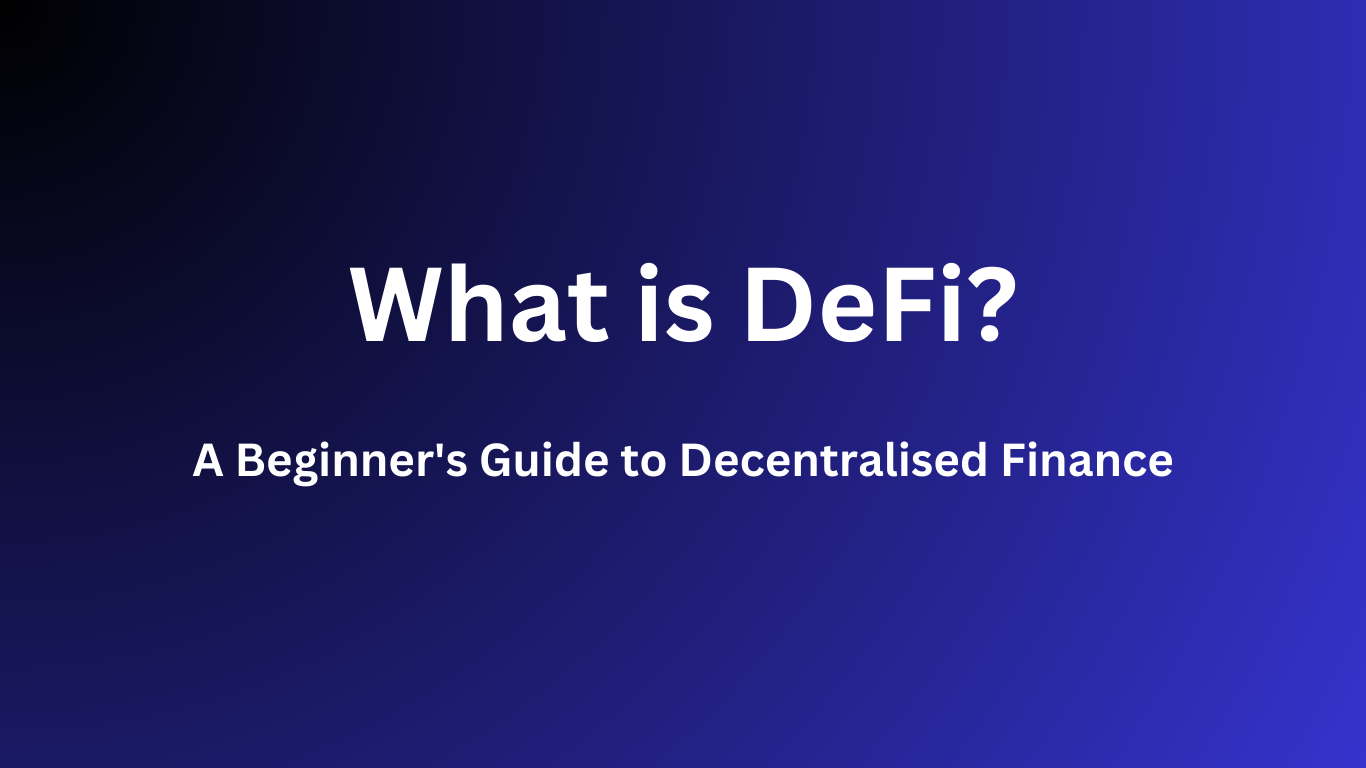Decentralised Finance, or “DeFi”, is a term used to describe financial services that operate on a public blockchain. In theory, everything that is possible in the traditional finance (TradFi) sector should also be possible within DeFi, but processes are typically faster and do not require a third-party intermediary.
As the name suggests, decentralised finance does not operate using a centralised system of control. Instead, it is global and peer-to-peer (P2P), which means that individuals or businesses communicate and transact directly with one another. Much like cryptocurrency in general, DeFi is pseudonymous and open to anybody that has access to the internet.
What is DeFi Used For?
Decentralised finance has a range of use cases, the most popular of which have been broken down in more detail below. DeFi and crypto are inextricably linked, and the two share a number of common goals. With that in mind, most DeFi services will involve cryptocurrency in some capacity.
Decentralised Exchanges
A decentralised exchange (DEX) is a P2P marketplace on which transactions take place directly between cryptocurrency traders. A DEX allows two users to trade one cryptocurrency for another, with the transaction being facilitated by smart contracts.
Algorithms are used to establish the price of one cryptocurrency compared to another, and liquidity pools – a pool into which investors deposit a cryptocurrency to earn rewards (interest) on it – enable trades to be executed automatically.
Uniswap and PancakeSwap are two of the most popular examples of a decentralised exchange. Uniswap is built on Ethereum and allows users to buy, sell and trade ERC-20 tokens. It is also currently the world’s largest DEX. PancakeSwap is native to BNB Chain, focusing on BEP20 tokens, a token standard developed by Binance.
Decentralised Applications
A decentralised application (dApp) is a software program that runs using blockchain technology and smart contracts. DApps are not controlled by a single entity and are instead powered by computer code, which is publicly available and can be adapted for a range of use cases.
Blockchain-based decentralised applications are transparent and accessible. Although they can be implemented across any industry, they are often used within the financial sector, facilitating peer-to-peer financial transactions. In fact, a decentralised exchange that operates using smart contracts would be a good example of a dApp.
Aave is one of the most well-known decentralised applications, excluding decentralised exchanges. Built on the Ethereum blockchain, Aave is a non-custodial liquidity market protocol, on which users can lend or borrow cryptocurrency tokens, with liquidity suppliers earning passive income rewards as a result.
Lending and Borrowing
Liquidity is one of the most important elements of crypto. It refers to the ease with which a cryptocurrency can be bought or sold, without dramatically impacting the price of the asset. As mentioned above, traders can put crypto tokens into a liquidity pool, which then acts as liquidity for anybody that wants to borrow or trade this asset.
Liquidity pools use smart contracts to enable trades and, unlike the traditional finance sector, automated market maker (AMM) algorithms automatically adjust prices based on supply and demand. This means that decentralised liquidity pools will often provide better prices for traders compared to centralised pools or TradFi markets.
As an incentive, users that deposit assets into a liquidity pool receive liquidity pool tokens (LPTs) – sometimes simply called pool tokens (PTs) or LPs – which act as a receipt that represents their share of the pool. Owning LPTs means that the holder is entitled to a percentage of any transaction fees generated by the pool, as well as any other rewards offered by the platform in question.
Rules will vary, but investors can usually withdraw their liquidity at any time by exchanging their LPTs for their deposited assets.
Yield Farming
Yield farming refers to the act of earning rewards on DeFi-related activities. Lending to a liquidity pool is a perfect example of yield farming; investors that deposit crypto assets earn a passive income as a result. However, there are a range of protocols that will offer traders and investors a percentage yield for their deposited cryptocurrencies.
Staking and yield farming are not dissimilar, although staking is used to secure a blockchain network whereas, traditionally, yield farming is used as a means of providing liquidity to a DeFi protocol. Yield farming is also inherently more risky than staking, although some methods are less risky than others.
Regardless, yield farming can provide opportunities for investors to earn much higher returns than would otherwise be possible through a traditional savings account. Platforms will usually clearly signpost to investors the annual percentage yield (APY) that they can expect to receive when lending a cryptocurrency and this can often be 10% or higher.
What Are The Key Benefits of DeFi?
Decentralised finance shares many of the fundamentals of blockchain technology and cryptocurrencies in general, and advocates of DeFi believe that it has the potential to positively disrupt the TradFi sector.
- Accessible – DeFi is open to everybody that has access to the internet. Investors are not limited by location, wealth or status, and it’s possible to start engaging with DeFi protocols simply by creating a cryptocurrency wallet.
- Pseudonymous – Investors can create a crypto wallet or start lending and borrowing without providing any real-world information such as a name, email address or home address.
- Up-to-date – Thanks to the use of smart contracts, most DeFi protocols – and the elements associated with them – update automatically. This means that interest rates and prices are usually adjusted continuously and instantly throughout the day.
- Flexible – Removing the reliance on third-party intermediaries or centralised bodies means that participants have complete control over their assets. It is possible to move, exchange or withdraw assets without asking permission or having to wait significant periods of time.
- Transparent – Although they’re pseudonymous, transactions are accessible to all, meaning that everybody involved can see what’s happening on a particular network at any given time. This transparency is rarely, if ever, experienced in TradFi.
- Secure – Blockchain technology is inherently secure and blockchains themselves are immutable, which means that transactions and data cannot be altered. The automation of processes also removes the risk of another party attempting anything malicious.
- Trustless – As DeFi protocols typically work on a peer-to-peer basis, it isn’t necessary to know – or trust – the person that you’re transacting with. The smart contract implemented by the protocol will automate any financial services, meaning that all DeFi protocols should, in theory, be entirely trustless.
What Are The Risks and Challenges of Decentralised Finance?
Although DeFi has many advantages, as with any financial service, there are some risks attached.
- Irreversible – Although smart contracts enable the automation of transactions, the lack of third-party involvement also means that many DeFi processes are irreversible. If a participant makes a mistake, such as sending a crypto asset to the wrong address or on the wrong network, it is usually impossible to rectify it.
- Flawed smart contracts – Smart contracts are also written in code, which does leave room for human error. If a developer makes a mistake when creating a smart contract, this could have negative repercussions for those trying to use that particular DeFi protocol.
- Complicated – Decentralised finance does rely on users having at least a cursory understanding of cryptocurrencies and blockchain technology. Although many dApps are user-friendly, the technology is not yet widely enough used to guarantee that anybody is able to use it with ease.
- Volatility – Some of the risks with DeFi are centred around the volatility of the crypto market. For example, locking a crypto asset into a smart contract for a set period of time might seem like a good idea, but if the price of that asset were to rise or fall drastically while it is locked away, you may not be able to take profit or minimise losses on a position.
Decentralised Finance (DeFi) vs Traditional Finance (TradFi)
Traditional finance, or TradFi, refers to all elements of the traditional finance system. This includes banking, the stock and bond markets, and everything in between. TradFi is well-established, with the buying, lending and borrowing of assets being well-regulated. This means that individuals and companies are afforded considerable protection when engaging with traditional financial services.
However, the traditional finance sector relies very heavily on centralised entities such as banks, governments and large corporations. For TradFi protocols and businesses to work, it is essential that individuals trust the entity that is managing their funds.
There are also additional drawbacks to traditional finance:
- Resistance to change – Historically, large TradFi organisations have been resistant to change. This is due to regulatory concerns and expensive operation costs, among other things.
- Expensive – Banks and brokers need to remain profitable, and so utilising a service will often incur relatively high fees.
These are some of the primary reasons that DeFi and cryptocurrency were introduced. Decentralised finance enables participants to take control of their own assets and removes the reliance on third-parties. DeFi protocols are typically faster and cheaper than their TradFi counterparts, although investors should be aware of the lack of regulatory protection attached to cryptocurrency and the wider decentralised finance sector.
The Future of DeFi
Although it’s impossible to predict exactly what the future of DeFi will involve, there are some commonly-held beliefs about what the sector could look like. Currently, a lack of education is the main barrier-to-entry for retail investors, but as cryptocurrency – and therefore DeFi – continues to see mainstream adoption, there is potential that a greater variety of protocols will be created. It’s also likely that these protocols will become more accessible and user-friendly, as time passes.
Tokenisation
Tokenisation is the ability to represent a real-world asset as a digital token on a blockchain. This could include real estate, luxury goods, artwork, and more. A tokenised asset can then be traded, potentially on a decentralised exchange, with the ownership of the asset in question being publicly visible on the blockchain.
There are two primary types of tokenised assets:
- Fungible – A fungible asset is interchangeable and divisible. Each unit of a tokenised asset has the same value as another and forms a part of the same network.
- Non-fungible – A non-fungible token (NFT) is not interchangeable or divisible, and each token is completely unique. Although they are not divisible, it can sometimes be possible to have part-ownership of a non-fungible asset.
It is likely that the tokenisation of real-world assets will continue to become a more widespread practice. As it grows in popularity, and a greater range of assets become tokenised, we will likely see the practice adopted more widely, further bridging the gap between TradFi and DeFi.
Conclusion
Decentralised finance is arguably one of the most innovative and important aspects in the fight for true decentralisation. With a goal of handing back control to investors, DeFi enables participants to utilise their finances in a range of different ways that would otherwise be impossible – or less effective – in TradFi.
Remember, there are plenty of risks involved with DeFi – a lack of regulatory control is a drawback that is difficult to overlook – but it’s important to consider whether the potential benefits might outweigh the negatives. Advocates for a decentralised future would certainly argue so.
FAQs
Is DeFi safe?
DeFi is very safe for those that know what they’re doing. Granted, there are malicious players and scammers involved in decentralised finance, but this is also the case within traditional finance. To stay safe in DeFi, make sure you conduct thorough research before committing real-money to any protocols. Set up two-factor authentication wherever possible and never give out your personal information or wallet keys to anybody.
What is the best way to get started in DeFi?
To get started in DeFi, it’s important that you first pick a blockchain and buy some cryptocurrency from a centralised exchange. Most DeFi protocols are built on the Ethereum blockchain, but gas fees can make this an expensive option for retail investors.
Once you’ve purchased some cryptocurrency, decentralised exchanges are probably the most beginner-friendly option within DeFi. Find a DEX that suits you, connect your crypto wallet and start trading.
Can you lose money in DeFi?
It is always possible to lose money in DeFi. Crypto is a very volatile asset class, which means that your crypto holdings can fall significantly in value within a short period of time. Sending money to the wrong address or on the wrong network can also lead to irrecoverable losses, and there is always the risk of networks or protocols going down while you have funds locked inside them.



